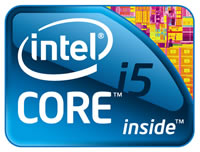Difference between Intel i3 and i5
Key difference: Intel Core i3 is a type of dual-core processor. i5 processors have 2 to 4 cores. A dual-core processor is a type of a central processing unit (CPU) that has two complete execution cores. A quad-core processor has four cores. Hence, it is twice as effective as a dual-core Intel Core i3 with its dual-core is meant to be an entry-level offering of Intel. The i5, on the other hand, is meant to be a mid-level offering, as it provides a better performance than the i3, due to its quad core availability. i5 also tends to be pricier than i3.
 A dual-core processor is a type of a central processing unit (CPU) that has two complete execution cores. Hence, it has the combined power of two processors, their caches and the cache controllers onto a single chip. This makes the dual-core processors well-suited for multitasking. Intel Core i3 is a type of dual-core processor. It is in fact the successor to the Intel’s Core 2 Duo line. A quad-core processor has four cores. Hence, it is twice as effective as a dual-core. i5 processors have 2 to 4 cores.
A dual-core processor is a type of a central processing unit (CPU) that has two complete execution cores. Hence, it has the combined power of two processors, their caches and the cache controllers onto a single chip. This makes the dual-core processors well-suited for multitasking. Intel Core i3 is a type of dual-core processor. It is in fact the successor to the Intel’s Core 2 Duo line. A quad-core processor has four cores. Hence, it is twice as effective as a dual-core. i5 processors have 2 to 4 cores.
Multiple-core processors (dual or quad) have cores that have an independent interface to the frontside bus. Each core has its own cache. This allows the operating system to have sufficient resources to handle intensive tasks in parallel. Intel Core i3 with its dual-core is meant to be an entry-level offering of Intel. The i5, on the other hand, is meant to be a mid-level offering, as it provides a better performance than the i3, due to its quad core availability. i5 also tends to be pricier than i3.
The main difference that sets i3 and i5 apart from the other dual cores is that the latest generation of i3 and i5 processors have a 22nm architecture. This is in comparison to the 45nm architecture which was the previous norm. i3 was originally released with a 32nm architecture, which was still impressive. The i5 was originally released with a 45nm architecture, but was subsequently decreased in following generations. The smaller width of the chip allows more transistors within the same silicon chip.
The size of the processors allows for the integration of the Direct Media Interface (DMI) and the Graphics Processing Unit (GPU) within the chip. The GPU makes the processor perform better and more uniformly on different motherboard brands. The DMI, on the other hand, shortens the electrical path between the core and the actual components like the RAM, hard drives, ports, and other resources.
This sets them apart from previous dual-cores. This also allows the i3 and i5 to consume less power, which leads to less heat generation, in addition to better and faster performance. The lower power consumption is especially a plus in laptops, as it increases battery life.
 As oppose to the previous dual core processors, both i3 and i5 also support Hyper-Threading Technology. Hyper-threading duplicates certain sections of the processor that store the architectural state but not duplicating the main execution resources. This allows the processor to appear as two processors, hence effectively scheduling two threads or processes simultaneously. The 3rd generation of i3 processors and the 3rd generation of i5 processors both host 4 threads.
As oppose to the previous dual core processors, both i3 and i5 also support Hyper-Threading Technology. Hyper-threading duplicates certain sections of the processor that store the architectural state but not duplicating the main execution resources. This allows the processor to appear as two processors, hence effectively scheduling two threads or processes simultaneously. The 3rd generation of i3 processors and the 3rd generation of i5 processors both host 4 threads.
The i3 and the i5 processors also have turbo boost. Turbo boost is a technology that allows the processor to overclock beyond its typical speed. This only happens when the operating system needs it to, the rest of the time the processors runs at its normal speed. The overclocking is only limited by the power and heat dissipation limits of the processor. The overclocking is extremely useful as it increases the computing power of the operating system. Both the 3rd generation of i3 processors and the 3rd generation of i5 processors support turbo boost. The design concept behind Turbo Boost is also commonly referred to as "dynamic overclocking".
Furthermore, all i3 processors have the same 3MB of cache, whereas the cache memory of the i5 processor ranges between 3MB to 6MB. Cache memory is important because it is much faster compared to RAM. A higher cache memory means that the processor accesses the slower RAM much less often.
A comparison between the two processors as per the Intel website:
|
|
Intel Core i3 |
Intel Core i5 |
|
Intel Smart Cache |
3MB |
3 - 6MB |
|
Intel Turbo Boost Technology |
Yes |
Yes |
|
Intel Hyper-Threading Technology |
Yes |
Yes |
|
# of Cores |
2 |
2 - 4 |
|
# of Threads |
4 |
4 |
|
Silicon |
22nm |
22nm |
|
Clock Speed |
1.8 - 3.4 GHz |
1.7 - 3.4 GHz |
Image Courtesy: doityourselfhtpc.wordpress.com, coolpctips.com









Add new comment